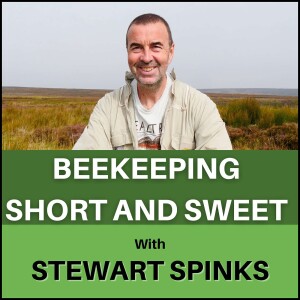
Episode 78: Cut Comb Honey, Tarts and Uniting Colonies
 2019-09-13
2019-09-13
This week I’m in the honey room preparing cut comb and chunk honey, cleaning up after extraction week and I’ve also been in the kitchen cooking up a fabulous Honey, Taleggio Cheese and Red Onion Tart so keep listening for the recipe.
I’ve definitely seen a change in the activity within our colonies this last week, the local forage has all but disappeared and quite a number of our bees are now heading into urban gardens to seek out the strange and the unusual for those last few drops of nectar and tiny bundles of pollen.
One of the most unusual plants I’ve seen honeybees foraging on here locally is a giant spike of a flower which must measure at least three metres tall and is the thickness of a telegraph pole. It turned out to be a tree Echium, it was huge, if you get a chance to take a look online then do, it was enormous. It was actually at a local garden centre which specialises in exotic plants and while many of our native plants such as bramble are all but finished a lot of these plants seemed to be in full flower still. A real blessing for many different pollinators.
I’d like to plant one of these giant Echium’s but I don’t think my garden or wallet will take the strain, maybe I’ll stick with native varieties, Vipers Bugloss being the most well known I suspect.
It’s meant the bees are currently chasing around finding tiny amounts of forage and waiting for the Ivy to flower, I’ve actually seen some Ivy at the allotments apiary almost in flower, certainly, the buds are very swollen and ready, it won’t be long I’m sure. This presents a challenge to the bees and beekeeper where it is in large quantities. It’s a much needed Autumn, nectar and pollen source for the bees and they do really well on it until the temperatures cool down and at that point, the Ivy honey granulates solid in the comb making it quite difficult for some colonies to utilise effectively. In some colonies, it can form a solid block preventing bees from move over or around it to get to liquid honey. And this is where beekeepers who heft and don’t notice the hive hasn’t really become lighter through the winter find the bees had a full brood box of solid Ivy honey but starved.
Not all colonies struggle with Ivy and some seem to not only work it well but thrive on it through the colder months. It can also provide a late Autumn surplus for the beekeeper to harvest, I know a lot of beekeepers dislike the taste but actually, I find it a really nice flavour, strong tasting with a slightly medicinal finish, that sounds like a wine tasting! One trick you can use to reduce the strong flavour is to either blend it with other honey or leave it in the bucket for a few months when the strong taste seems to mellow somewhat. Either way, I really like it.
Back to this week though and some of my colonies have become quite grumpy, in fact, horribly grumpy, so much so I would class a couple of them as “double glovers”, it’s an expression that refers to the need to put on two pairs of nitrile gloves instead of the usual single pair. I made the mistake of picking up some supers for extraction without putting my boots on and cracking the supers off the clearer boards really wound them up and you just know they’re going to find the one vulnerable place you’ve left exposed! After several minutes of collecting supers with bees stinging my ankles I looked like I was walking barefoot across sun-baked sand, hopping and cursing as I went, funny now, but at the time, not so amusing!
The colonies will calm down again quite quickly, it’s that sudden loss of forage and this immediately followed by the beekeeper removing surplus honey that seems to get them a little feisty. We have the remaining treatments to put on this week, as I mentioned in previous podcasts we’re using Apivar and this needs to go in the hives after the honey has been removed hence the slight delay in some apiaries as we remove supers for extraction.
As we sorted through
More Episodes
 2021-02-12
2021-02-12
 2021-02-05
2021-02-05
 2021-01-15
2021-01-15
 2020-12-11
2020-12-11
 2020-12-04
2020-12-04
 2020-11-27
2020-11-27
 2020-11-20
2020-11-20
 2020-11-06
2020-11-06
 2020-10-30
2020-10-30
 2020-10-16
2020-10-16
Create your
podcast in
minutes
- Full-featured podcast site
- Unlimited storage and bandwidth
- Comprehensive podcast stats
- Distribute to Apple Podcasts, Spotify, and more
- Make money with your podcast
It is Free
- Privacy Policy
- Cookie Policy
- Terms of Use
- Consent Preferences
- Copyright © 2015-2024 Podbean.com




